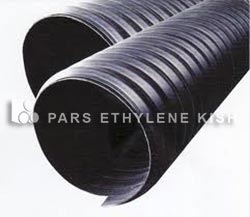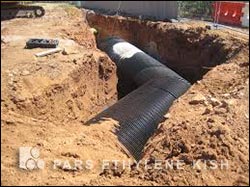
Advantages of Polyethylene Underground Pipe
PE pipe (polyethylene pipe) enables the world’s underground infrastructure to have a backbone that is cost-effective, strong, durable, long lasting, easy to install and secure. But within the world of PE materials only certain grades are “pipe-worthy.” Just like there are different grades of metal and concrete used in various applications, there are different kinds of PE designed for myriad industrial and consumer applications. And there are different grades within these application categories.
So how do you know that the pipe you need is made from the right PE material for your specific pipe application?
First a little background. The Imperial Chemical Company of England formulated and first produced polyethylene plastic resin in 1933. It was, however, a costly process. During the next 20 years, chemists in the petrochemical industry continued to advance the manufacturing process to diminish costs while yielding better grades of PE. In the early 1950s, chemists at the Phillips Petroleum Company developed an economical process and delivered a new grade of PE called high-density polyethylene, also known as HDPE. At that time it became possible to create various grades of PE and soon the resin was being used in a wide variety of products and applications.
The first use of PE was for baby bottles. Using PE instead of glass was the start of PE replacing traditional materials due to its improved physical properties. In this instance it didn’t break like glass, it was less expensive to produce and it was safe for mother’s milk or formula. Today, PE has not only replaced glass for bottles (including milk and shampoo) but also metal for pails, drums, gas tanks and a host of other applications.
For pipe, the grade of PE used now is very different from early generation materials, and even very different from other PE materials used in today’s consumer applications – like packaging, film, bottles, etc. Pipe grade PE is a highly engineered compound that is designed for long-term service in critical applications and put through a series of rigorous testing procedures before it is available for manufacturing.
Solid wall PE pipe began replacing metal pipe in oil and gas gathering systems in the late 1950s. In the early 1960s, gas utilities started replacing fa iling iron pipes with PE, and because of its successful performance history, 95 percent of all new gas distribution systems installed today are PE pipe. Later in that decade, PE pipe started to replace clay pipe in agricultural drainage systems. Then, service utilities began to see the benefit of using PE for conduit, water and sewer applications, and in the late 1980s PE began to replace metal and concrete in storm water culverts. Also, cross-linked PE (also known as PEX) has shown itself to be an alternative to copper pipe for residential plumbing. PE materials have continued to evolve into what is now their third and fourth generation of development, each with improved performance capabilities.
iling iron pipes with PE, and because of its successful performance history, 95 percent of all new gas distribution systems installed today are PE pipe. Later in that decade, PE pipe started to replace clay pipe in agricultural drainage systems. Then, service utilities began to see the benefit of using PE for conduit, water and sewer applications, and in the late 1980s PE began to replace metal and concrete in storm water culverts. Also, cross-linked PE (also known as PEX) has shown itself to be an alternative to copper pipe for residential plumbing. PE materials have continued to evolve into what is now their third and fourth generation of development, each with improved performance capabilities.
PE piping systems are a sustainable and environmentally responsible choice that will serve generations to come. They are energy efficient during manufacturing and provide peak protection from contamination during service. Plus they require significantly less energy to fabricate, transport and install than metal or concrete alternatives. With superior resistance to corrosion and abrasion, plastics piping systems also supply long service life, excellent joint performance and offer leak-free protection.
Breaking the Code
Beyond the standards for the material formulated to make PE pipe, it is important to note that PE pipe is manufactured, certified, and installed in accordance with numerous industry standards from organizations such as AWWA, ASTM, CSA, IAPMO, API, NSF, and FM. By submitting products and passing independent tests, manufacturers assure customers that products meet the requirements of the standard, including the requirements on physical properties, joining, and installation methods.
Much of this information is printed on the pipe. These organizations and the standards and codes they put forward provide insight into the materials and pipe, and the appropriate end-uses. But what do all those letters and numbers found in the pipe print-line mean and how can this valuable information help you to make an informed decision?
For pressure pipe applications, the main material description is known as the Standard Pipe Material Designation Code. This Code encompasses important technical information about the material including the recommended Hydrostatic Design Stress or HDS, which defines the maximum design stress for a pipe made from the PE compound, as well as other important performance properties. This is an important criterion to know because it is a great aid in making sure the right material is used for an application. From the HDS, the maximum operating pressure of the pipe for water at 73 F is determined. If the conditions warrant, additional de-rating factors can be applied by the design engineer, and knowing the HDS by looking at the pipe print string is a valuable bit of information.
The pipe material designation codes continue to evolve as newer materials are developed. The latest development in PE pipe resin classification is PE 4710. This translates to the ability to utilize a thinner walled pipe and still meet the same pressure specifications with increased flow capacities and without compromising safety or long-term service.
Improvements in PE pipe resin and in manufacturing are a continuous process, and the codes must evolve to reflect these changes. Therefore, as these improved materials are introduced, pipe manufacturers may imprint the pipe with .jpg) the old and new codes in order to meet engineering design or purchase specifications. It is typical to see, for example: PE 3408/PE 4710 on one pipe. The PPI’s reference card called The New PE Pipe Material Designation Codes lists the historical and new codes as well as the associated design parameters, which is helpful in deciphering the data.
the old and new codes in order to meet engineering design or purchase specifications. It is typical to see, for example: PE 3408/PE 4710 on one pipe. The PPI’s reference card called The New PE Pipe Material Designation Codes lists the historical and new codes as well as the associated design parameters, which is helpful in deciphering the data.
It, along with PPI’s encyclopedic Handbook of Polyethylene Pipe, the PEX Design Guide, and The Corrugated Pipe Design Guide and Installation Manual can be helpful additions to technical libraries and field operation manuals. These reference materials are available at www.plasticpipe.org.
The Plastics Pipe Institute (PPI) also has relevant technical bulletins available. The PPI’s Technical Report-3, or TR-3, are the policies and procedures for establishing the long-term strength for all thermoplastic materials used in pressure pipe applications. The results of these tests are found in the PPI’s Technical Report-4, TR-4, which lists the hydrostatic design basis (HDB) as well as the hydrostatic design stress (HDS), which has been used by engineers in designing piping systems since it was first published more than 40 years ago.
Solid wall pipe as typically used in potable water uses a PE 3608 or PE 4710, or similar grade, and gas distribution pipe is typically made from a PE 2708 or PE 4710 compound. For residential and commercial plumbing and heating applications, tubing is made from PEX, also known as cross-linked polyethylene, and is available in various designation codes depending on the application needs. And for nuclear power plant, a PE 4710 resin is mandatory to provide the required physical properties for this critical application.
Here’s an example of how to decipher the Standard Pipe Material Designation Code for a pipe imprinted with PE 4710:
PE indicates it is a polyethylene piping material
♦ 4 – the first digit identifies the PE resin’s density cell clarification in accordance with ASTM D 3350. This ASTM standard classification can range from 1 (lowest on the scale) up to 5.
♦ 7 – the second digit identifies the material’s classification for slow crack growth resistance, also in accordance with ASTM D 3350. This value can range from 1 to 7, with 7 being the highest resistance rating. As a point of reference, slow crack growth has improved 500 times over the earliest grades of PE pipe resins.
♦ 10 – the third and fourth digits actually make up one number. The number 10 denotes the material’s recommended hydrostatic design stress (HDS) in units of 100 psi.
source:
http://www.uimonline.com